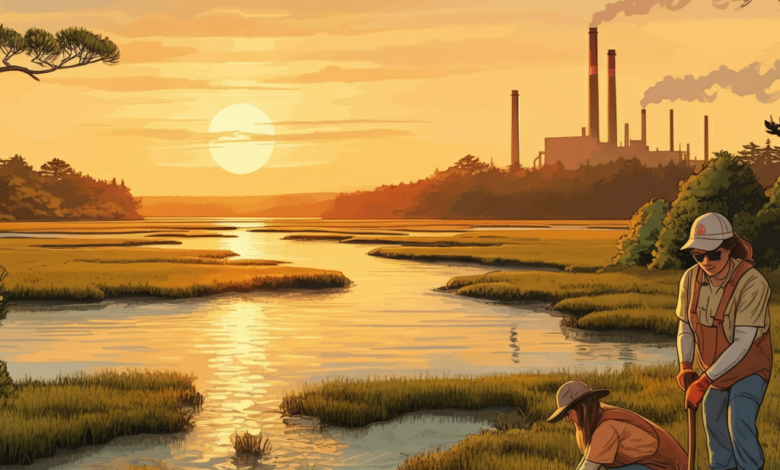How Have Estuaries Been Impacted? A Look at Their Challenges and Future

Estuaries are among the most dynamic and vital ecosystems on Earth, serving as the meeting point of freshwater rivers and the salty ocean. These coastal regions are rich in biodiversity, acting as nurseries for marine life, natural water purifiers, and protective barriers against storms. Yet, estuaries are facing unprecedented challenges that threaten their survival and the critical roles they play in the environment.
If you’re a nature enthusiast eager to understand more about estuaries and their current state, this blog will walk you through their importance, the impacts of environmental changes, and the initiatives aimed at their protection.
What Is an Estuary and Why Does It Matter?
Estuaries are semi-enclosed coastal bodies of water where freshwater from rivers and streams mixes with saltwater from the ocean. These unique environments host an incredibly diverse range of plant and animal species. From shrimp and crabs to migratory birds and manatees, estuaries are bustling with life.
Their significance goes beyond being biodiversity hotspots. Estuaries provide multiple ecological and economic benefits, such as:
- Nurseries for marine life: Many fish and shellfish species use estuaries as breeding and feeding grounds.
- Buffer zones: Estuaries act as natural barriers, absorbing storm surges and reducing coastal erosion.
- Water filtration: They help filter pollutants, improving water quality for humans and marine ecosystems.
- Economic value: Estuaries support industries such as fishing, tourism, and transportation.
However, these critical ecosystems depend on stable environmental conditions – something that is rapidly changing.
How Have Estuaries Been Impacted by Environmental Changes?
The answer to “how has estuaries been impacted?” lies in exploring the numerous pressures they face today. Let’s take a closer look at three major contributors to their decline.
1. Climate Change
Climate change has been a game-changer for estuaries. Rising global temperatures cause a domino effect of issues, such as rising sea levels, shifts in salinity levels, and the destruction of coastal habitats. Warmer waters also reduce oxygen levels, which impacts aquatic species’ survival.
Estuaries like the Chesapeake Bay in the United States are experiencing more frequent “dead zones,” areas where oxygen is too low for most marine life to survive, due to warming waters and nutrient runoff.
2. Pollution
Pollution presents a direct threat to the delicate balance of estuary ecosystems.
- Nutrient overloads: Excess fertilizers from agricultural runoff lead to algal blooms, which block sunlight and ultimately result in oxygen-starved environments.
- Chemical contamination: Industrial waste and heavy metals poison the water, making it unsafe for wildlife and humans alike.
- Plastic waste: Estuaries collect significant amounts of plastic debris, which harms marine animals and breaks down into microplastics.
For instance, the Indian Sundarbans, a UNESCO World Heritage site, is grappling with poor water quality due to pollution, which jeopardizes its famed mangrove forests and wildlife species like the Bengal tiger.
3. Human Activities
Urban development, deforestation, and overfishing add significant stress to estuaries.
- Coastal developments: Across the globe, urban sprawl and port expansions have drained or filled estuaries, causing habitat loss.
- Overfishing: Excessive harvesting of fish and shellfish disrupts the estuary food web and reduces biodiversity.
- Sand mining: This practice damages estuarine ecosystems by altering water flow and eroding riverbanks.
Take the Mekong Delta in Vietnam, for example—extensive sand mining and dam construction have disrupted sediment flow and led to the erosion of agricultural land, harming local communities.
Case Studies of Estuaries Facing Challenges
To better understand the impact of these challenges, here are three real-world examples of estuaries under threat.
1. Chesapeake Bay, USA
Known as one of the largest estuaries in the United States, Chesapeake Bay is a crucial ecosystem. However, it faces repeated algal blooms caused by nutrient pollution from surrounding cities and agricultural practices. On top of that, rising sea levels are threatening its wetlands and shoreline habitats.
2. Sundarbans, India and Bangladesh
The Sundarbans is the world’s largest tidal halophytic mangrove forest, home to rare species such as the Bengal tiger. Unfortunately, it’s highly vulnerable to pollution, rising sea levels, and human encroachment. Conservation efforts are currently underway to tackle these issues.
3. The Mekong Delta, Vietnam
The Mekong Delta serves millions of people as a vital source of food and fresh water. However, unsustainable sand mining, along with dam construction upstream, has severely affected its water flow and sediment distribution.
Global and Local Efforts to Protect Estuaries
Protecting estuaries is now a priority for many communities and environmental organizations. Here’s how some initiatives are making an impact.
Global Conservation Efforts
- The Ramsar Convention: This international treaty protects wetlands of international importance, including many estuaries.
- Mangrove Reforestation: Projects across Asia and Africa are restoring these essential coastal ecosystems, which protect estuaries from erosion and flooding.
Local Initiatives
- Chesapeake Bay Foundation (CBF): The organization runs cleanup efforts and enforces stricter regulations to combat nutrient and pollution loads in the bay.
- Eco-tourism in the Sundarbans: Sustainable tourism initiatives allow travelers to explore this natural wonder without negatively affecting its ecosystem.
What Can You Do?
You don’t need to be a scientist to contribute to estuary conservation. Here’s how you can help protect these ecosystems.
- Reduce your use of single-use plastics to prevent pollution.
- Volunteer for local cleanup events in your area.
- Support organizations working to restore estuaries and wetlands.
- Advocate for sustainable agricultural practices to minimize fertilizer runoff.
The Future of Estuaries Depends on Us
The fate of estuaries is in our hands. Without immediate action, the vital services estuaries provide—coastal protection, water filtration, and habitats for marine life—may be permanently lost. The challenges are great, but so is the potential to make a difference.
From global treaties like the Ramsar Convention to local grassroots clean-ups, efforts to restore estuaries are encouraging. However, sustained focus and collective action are critical for meaningful progress.



